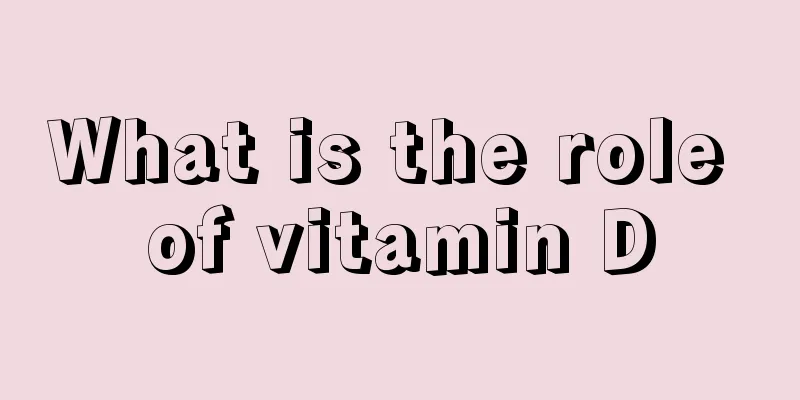What is the role of vitamin D

|
Vitamin D has many medicinal values. It is a vitamin needed by the human body. It is very good for promoting the absorption of calcium and phosphorus. It also helps prevent cancer and reduce the incidence of heart disease. Children's lack of vitamin D will lead to rickets. Therefore, it is recommended that everyone can understand the functions of vitamin D and supplement vitamin D in time. 1. Promote the absorption of calcium and phosphorus The most well-known function of vitamin D is to promote the absorption of calcium and phosphorus, and prevent rickets in children and osteomalacia in adults, because rickets is a disease caused by vitamin D deficiency that causes calcium and phosphorus metabolism disorders. 2. Prevent cancer Vitamin D plays a role in regulating cell proliferation, but this regulatory mechanism is lacking in cancer patients. Therefore, by preventing cells from over-multiplying, vitamin D may protect against certain cancers. 3. Reduce the risk of heart disease Vitamin D can reduce insulin resistance, which is one of the main factors leading to heart disease. 4. Relieve diabetes In type 1 diabetes, the immune system kills the body's own cells. Scientists believe that vitamin D may act as an immunosuppressant, which they think may prevent the immune system from overreacting. 5. Regulate blood pressure Vitamin D is used by the parathyroid glands on the thyroid gland in the neck. These glands secrete a hormone that regulates calcium levels in the body, and calcium helps regulate blood pressure. Symptoms of vitamin d deficiency 1. Bone pain. Adults who are deficient in vitamin D are more likely to experience bone and muscle pain, especially in the winter. Stiffness in joints when getting up in the morning. 2. Depression. Vitamin D can improve levels of the neurotransmitter serotonin, which can improve mood. Studies have found that vitamin D supplementation can significantly reduce the incidence of depression. 3. Aged over 50. The American Cancer Society says that as we age, our skin becomes less able to produce vitamin D. The elderly spend relatively more time indoors and relatively less time in the sun, making them more likely to suffer from vitamin D deficiency. 4. Overweight or obese. Excess body fat can lower blood vitamin D levels. The reason is that vitamin D is fat-soluble. The more body fat you have, the easier it is to be "diluted". People who are overweight or obese may need more vitamin D supplementation. 5. Dark skin. Several studies have shown that skin pigments act as natural sunscreens. Wearing an SPF 30 sunscreen reduces the skin's ability to make vitamin D by 97 percent. Dark-skinned people need to spend 10 times more time in the sun to get the same amount of vitamin D as white-skinned people. 6. The head sweats easily. Sweating on the head is a typical symptom of vitamin D deficiency. 7. Intestinal problems occur. Studies have found that Crohn's disease and celiac or enteritis can affect fat absorption and thus make vitamin D deficiency more likely. What to eat to supplement vitamin D 1. Fatty fish. Fatty fish is an excellent source of vitamin D. These include: salmon, trout, mackerel, tuna, eel, etc. Plus, you get heart-healthy omega-3 fatty acids. 2. Canned tuna. It's not only fresh fish that can provide vitamin D, canned products can also provide it. Canned tuna and canned sardines are rich in vitamin D and are much cheaper than fresh fish. 3. Mushrooms. Just like the human body, mushrooms are able to produce vitamin D. However, mushrooms mostly grow in dark places, so they do not contain vitamin D themselves. However, when they are exposed to ultraviolet rays, they will promote the production of vitamin D. 4. Egg yolk. Egg yolk is the simplest and most convenient way to obtain vitamin D. Since vitamin D is hidden in the egg yolk, the whole egg is the most nutritious. But if you just want to supplement vitamin D by eating eggs, you are wrong. One egg contains about 200 mg of cholesterol. Studies have found that a person's daily cholesterol intake should not exceed 300 mg, otherwise it will endanger heart health. 5. Fortified cereals. Eating fortified cereals is also a good way to get vitamin D. Choosing multigrain cereal or other low-calorie fortified cereals is a good way to get vitamin D. Fortified milk and fortified orange juice are also good choices. 6. Beef liver. Although it is not the best way to obtain vitamin D, it can still meet the vitamin D intake. In addition, it also contains a variety of nutrients, such as vitamin A, iron and protein. However, beef liver is high in cholesterol, so you need to be careful when eating it. |
>>: What vitamins promote calcium absorption
Recommend
Why do I feel dizzy and my eyes go dark when I wake up?
In real life, many people have experienced dizzin...
The difference between eel and rice field eel
Although eels and rice field eels look very simil...
What are the laws for preventing and controlling noise pollution
Noise is everywhere in our lives. It is a kind of...
What is the reason for dead skin on the heels_What is the reason for dead skin on the feet
Soaking your feet is something many people do bef...
What are the hazards of carbon monoxide to the human body
It is the coldest time of the year again. Althoug...
Urine is golden yellow
A normal person's urine should be transparent...
Can silica gel be used as a food desiccant?
Food desiccant is a very common thing. Only in th...
Who are not suitable for eating pickled peanuts in vinegar?
Peanuts are a food that many people love to eat. ...
Detailed explanation of what is hamartoma
The incidence of hamartoma is getting higher and ...
Can prostate cancer patients still have their own children?
Can patients with prostate cancer still have thei...
What are the hazards of mercury to the human body
Everyone knows about mercury. We talked about it ...
What are the symptoms of esophageal cancer that are easily overlooked
Esophageal cancer is often caused by bad eating h...
Symptoms of obesity
Obesity, as the name suggests, is a disease that ...
Let me briefly introduce the diagnostic method of esophageal cancer
Esophageal cancer is a common disease, and patien...
How to wash down jackets cleanly and easily
In the cold winter, down jackets are a type of cl...









